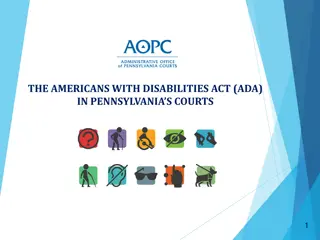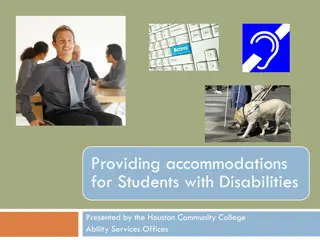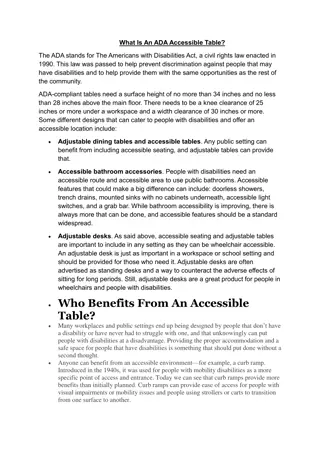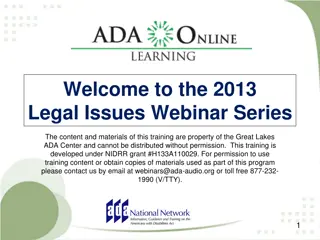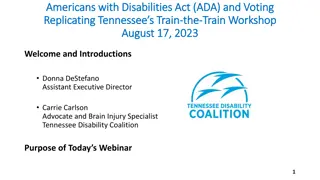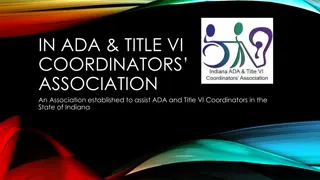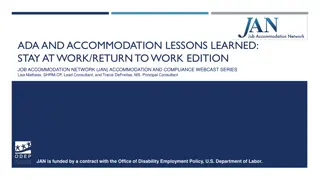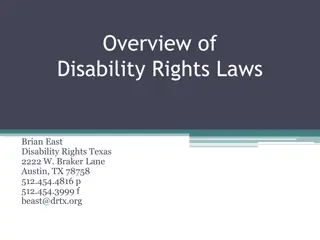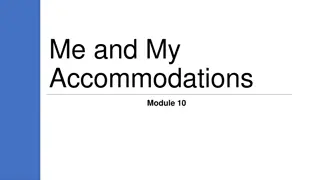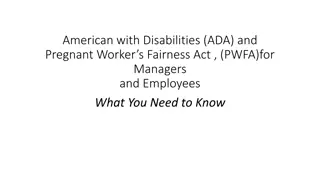Americans with Disabilities Act (ADA)
The Americans with Disabilities Act (ADA) provides protection for individuals with physical or mental impairments that substantially impact major life activities. It is divided into four categories, covering employment, public services, and public accommodations. The ADA requires accessibility in new construction for public accommodation and commercial facilities.
Download Presentation

Please find below an Image/Link to download the presentation.
The content on the website is provided AS IS for your information and personal use only. It may not be sold, licensed, or shared on other websites without obtaining consent from the author.If you encounter any issues during the download, it is possible that the publisher has removed the file from their server.
You are allowed to download the files provided on this website for personal or commercial use, subject to the condition that they are used lawfully. All files are the property of their respective owners.
The content on the website is provided AS IS for your information and personal use only. It may not be sold, licensed, or shared on other websites without obtaining consent from the author.
E N D
Presentation Transcript
ADA The Americans with Disabilities Act GROUP #3 DOMINIC MARTINEZ Building Tech 3 Professor P. King
Protection Under the ADA Protects individuals defined as disabled: Physical or mental impairment that substantially impacts on one or more major life activities Record of such impairment Regarded as having such an impairment
Titles of the ADA Divided into four categories: Employment (Title I) State & Local Government(Title II) Public Accommodation and Commercial Facilities(Title III)
Title I: Employment Applies to: Employers with more than 15 employees (excluding federal government and private clubs) Schools that have more than 50 employees Employment agencies, labor organizations and labor-management committees Qualified persons with a disability that are able to perform the essential functions of a job with or without reasonable accommodations
Title II: Public Services Protects against discrimination in public transportation Includes rail or bus services Excludes air travel Includes intercity or commuter rail services Excludes public school transportation
Title III: Public Accommodations Applies to: Hotels and motels Bars and restaurants Theaters and museums Stores and shopping centers Hospitals and professional offices Amusement parks and zoos Nurseries and private schools Day care centers and homeless shelters Gyms and health clubs
What does the ADA require in new construction? The ADA requires that all new construction of places of public accommodation, as well as of "commercial facilities" such as office buildings, be accessible. Elevators are generally not required in facilities under three stories or with fewer than 3,000 square feet per floor. The 2010 ADA Standards for Accessible Design set minimum requirements both scoping and technical -- for newly designed and constructed or altered public accommodations and commercial facilities to be readily accessible to and usable by individuals with disabilities. Source: Title III 2010 ADA Standards
405.2 Maximum Ramp Slope and Rise for Existing Sites, Buildings, and Facilities Slope1 Maximum Rise Steeper than 1:10 but not steeper than 1:8 3 inches (75 mm) Steeper than 1:12 but not steeper than 1:10 6 inches (150 mm) A slope steeper than 1:8 is prohibited.
Advisory Specifications for Water Closets Serving Children Ages 3 through 12 Ages 3 and 4 Ages 5 through 8 Ages 9 through 12 12 inches 12 to 15 inches 15 to 18 inches Water Closet Centerline (305 mm) (305 to 380 mm) (380 to 455 mm) 11 to 12 inches 12 to 15 inches 15 to 17 inches Toilet Seat Height (280 to 305 mm) (305 to 380 mm) (380 to 430 mm) 18 to 20 inches 20 to 25 inches 25 to 27 inches Grab Bar Height (455 to 510 mm) (510 to 635 mm) (635 to 685 mm) 14 inches 14 to 17 inches 17 to 19 inches Dispenser Height (355 mm) (355 to 430 mm) (430 to 485 mm)
Source http://www.access-board.gov/guidelines-and-standards/buildings-and-sites/about-the-ada- standards/background/adaag#4.13



